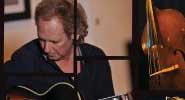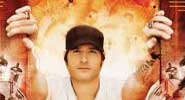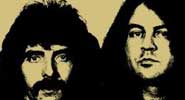 Ritenour’s previous album, 6 String Theory, featured collaborations with guitar peers John Scofield, B.B. King, Slash, and George Benson, among others. Here, he’s working with virtuoso rhythm section players – and a few newcomers.
Ritenour’s previous album, 6 String Theory, featured collaborations with guitar peers John Scofield, B.B. King, Slash, and George Benson, among others. Here, he’s working with virtuoso rhythm section players – and a few newcomers.
Bassists on these 12 numbers include Stanley Clarke, Christian McBride, Marcus Miller, Chuck Berghofer, Nathan East, and Tal Wilkenfeld. On keyboards: George Duke, Ariel Mann, Debon Johnson, Patrice Rushen, Chick Corea, Alan Pasqua, Dave Grusin, and Larry Goldings. The drummers are equally prestigious: Will Kennedy, Peter Erskine, Sonny Emory, Dave Weckl, Oscar Seton, and Willie Colaiuta.
The material runs the gamut, the performances nuanced to compliment this diverse lineup. One standout is a restrained, atmospheric treatment of Nick Drake’s moody “River Man” with a vocal by jazz singer Kurt Elling, the band (including Grusin and East) creating a complementary mood. Ritenour plays classical on Chick Corea’s airy “Children’s Song # 1,” easily interacting with the song’s composer. Grusin’s 1989 “Punta Del Soul” showcases the five rhythm section winners of Ritenour’s 2012 International 6-String Theory Competition.
“Fat Albert Rotunda” lacks the horn sections of Herbie Hancock’s 1969 original, yet Ritenour more than compensates. Assisted by Rushen’s and Johnson’s keyboards and the basses of Miller and Melvin Lee Davis, they update the feel while retaining the original’s funk groove. On “Maybe Tomorrow,” he adds stinging embellishments in and around South African vocalist Zamajobe. His lines are likewise strong on “Spam-Boo-Limbo.”
The Ritenour originals vary in tone, from the medium-tempo “July” and “800 Streets by Feet’s” glimmering textures to “The Village’s” swirling textures.
Ritenour’s intent here was to showcase the great rhythm players of the moment, spanning generations, and those sure to make their mark in the future. Rhythm Sessions, thoroughly musical throughout, manages to do that admirably.
This article originally appeared in VG‘s Jan. ’13 issue. All copyrights are by the author and Vintage Guitar magazine. Unauthorized replication or use is strictly prohibited.


 G&L’s Tribute Series Fallout has a mahogany body with Paul-Gagon-designed P-90 neck pickups and a splittable bridge humbucker. It uses a Saddle Lock bridge, a medium-C neck shape with 12” radius, and is available in several finish options. Learn more at www.glguitars.com.
G&L’s Tribute Series Fallout has a mahogany body with Paul-Gagon-designed P-90 neck pickups and a splittable bridge humbucker. It uses a Saddle Lock bridge, a medium-C neck shape with 12” radius, and is available in several finish options. Learn more at www.glguitars.com. The Lehle Basswitch IQ A/B switcher/DI uses high-grade components and has a parametric EQ, effects footswitch, and clean-boost capabilities. For more, go to www.rmi.lu.
The Lehle Basswitch IQ A/B switcher/DI uses high-grade components and has a parametric EQ, effects footswitch, and clean-boost capabilities. For more, go to www.rmi.lu. The Buffalo FX Germanium Fuzz V2 is built using NOS Texas Instrument 2N404 transistors, Neutrik jacks, Vishay caps, screened cabling, and low-current ultrabrite LED indicators. It has controls for Fuzz, Level, Pre-Gain, and Bias, and has top-mounted jacks. It is powder coated and hand-wired with true-bypass switching. Learn more www.buffalo-fx.com.
The Buffalo FX Germanium Fuzz V2 is built using NOS Texas Instrument 2N404 transistors, Neutrik jacks, Vishay caps, screened cabling, and low-current ultrabrite LED indicators. It has controls for Fuzz, Level, Pre-Gain, and Bias, and has top-mounted jacks. It is powder coated and hand-wired with true-bypass switching. Learn more www.buffalo-fx.com. The Electro-Harmonix 8 Step Program connects to an expression pedal or control-voltage input on another device to give sequencer control over parameters that respond to expression pedals or CV generators such as oscillators, filters, delay parameters, etc. Sequences can be modified with the pedal’s multi-function Mode switch that delivers control over sequence length, direction, depth and glide rate. It has four direction modes – Forward, Reverse, Bounce, and Random – and its sequence rate can be set with the Rate slider, Tap Tempo footswitch, or via MIDI clock, which permits syncing to an external device like a drum machine. Five Tap Tempo Divide modes add rhythmic diversity. An expression pedal/CV input enables external, real-time control of rate, depth, glide, and sequence length. It can store 10 user pre-sets, and an optional foot controller expands pre-sets to 100. Learn more at www.ehx.com.
The Electro-Harmonix 8 Step Program connects to an expression pedal or control-voltage input on another device to give sequencer control over parameters that respond to expression pedals or CV generators such as oscillators, filters, delay parameters, etc. Sequences can be modified with the pedal’s multi-function Mode switch that delivers control over sequence length, direction, depth and glide rate. It has four direction modes – Forward, Reverse, Bounce, and Random – and its sequence rate can be set with the Rate slider, Tap Tempo footswitch, or via MIDI clock, which permits syncing to an external device like a drum machine. Five Tap Tempo Divide modes add rhythmic diversity. An expression pedal/CV input enables external, real-time control of rate, depth, glide, and sequence length. It can store 10 user pre-sets, and an optional foot controller expands pre-sets to 100. Learn more at www.ehx.com.

 Renowned songwriter/singer/guitarist J.J. Cale passed away July 26 at a hospital in La Jolla, California, after suffering a heart attack. He was 74.
Renowned songwriter/singer/guitarist J.J. Cale passed away July 26 at a hospital in La Jolla, California, after suffering a heart attack. He was 74.




